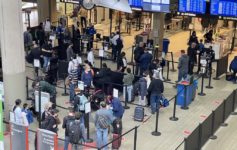As Labor Day approaches, travelers across the United States are gearing up for what promises to be one of the busiest travel weekends in recent memory. This surge in travel activity marks the unofficial end of summer and highlights the continued demand for air travel, even in the face of ongoing challenges.
If you are considering booking travel or signing up for a new credit card please click here. Both support LiveAndLetsFly.com.
If you haven’t followed us on Facebook or Instagram, add us today.
Record Numbers Expected
Labor Day weekend has always been a popular time for travel, but this year is set to break records. The Transportation Security Administration (TSA) has reported that air travel numbers are expected to reach an all-time high, with millions of Americans taking to the skies. United Airlines, in particular, has projected that this will be their busiest Labor Day on record, underscoring the widespread eagerness to travel.
While some carriers are reporting a tapering in demand, the summer has still held strong with record individual day numbers several times throughout the last few months. Whether there is actual all-time high traveler numbers remains to be seen, but elevated over years past and especially during the pandemic, will lead to longer lines, waits, and full flights.
The Broader Impact of Increased Travel
This surge in travel activity has broader implications for the travel industry and beyond. Airlines have been working to ramp up operations during peak travel periods like Labor Day, while at the same time countering higher costs, and waning demand outside of peak windows.
Airlines like Spirit, and JetBlue have reduced pilots. Most airlines in the United States are flying with smaller and less reliable fleets than anticipated as manufacturing woes have hit both Boeing and Airbus. These concerns, along with a restless flight attendant union at United could further complicate a busier-than-normal period.
One important factor is just how many travelers choose to fly during this weekend. It has the potential to quiet critics (like myself) who have cited data showing a downward trend for passenger loads, and subsequently, airline profits. If US travelers show resiliency and a surge, it could confuse industry executives as to which way the trend line is headed.
Looking Ahead
While Labor Day weekend marks the end of the summer travel season, the trends observed during this period could carry over into the fall and beyond. With remote work becoming more common, the lines between traditional travel seasons are blurring, allowing for greater flexibility in when and how people travel. But with warning signs flashing, it’s also possible this weekend earmarks the start of the drop in earnest.
What do you think?




I’ve been generally more positive on travel demand trends (and the economy) thank you have been – but I think just looking at TSA numbers may be painting too optimistic of a picture, especially for revenues…
More people are traveling now than pre-pandemic, and that is a definite trend. However, business travel is still behind trend, and airlines still haven’t figured out how to optimize schedules and routes. Airline capacity has clearly outpaced organic domestic demand, and international destinations (especially Europe, Caribbbean and LatAm) have stolen share from US travel destinations. Airbnb also continues to grow capacity. All the while, operating costs are up across travel, and customers are more price sensitive due to inflation. So hotel and airfares prices are down even with solid demand.
Overall, demand will remain strong, but it will be less profitable than people hoped for. But if you are looking for a drop off in demand in the fall, I think that is misplaced – September and October will be strong, mainly because that’s when business travel comes back. Business travel has become really concentrated – it’s more of a March-June and September/October thing nowadays. So I think you will continue to just see very good demand, but modest revenue growth and flat/down profitability for the time being.